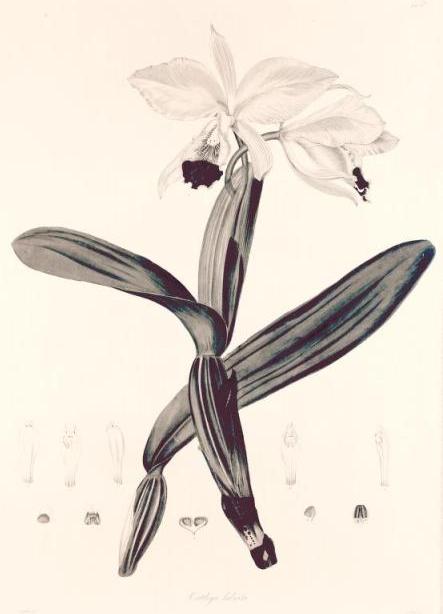
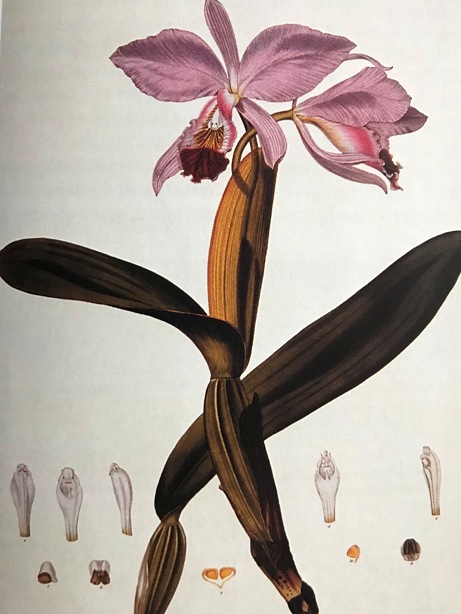
The first published image of Cattleya labiata, in John Lindley's Collecteana Botanica, vol. 33 (1824). On the left, the digitized image from the copy at the Missouri Botanic Garden, badly faded. On the right, an image from a copy that hasn't faded so much, found on Facebook.
March, 2020

Blast from Our Past: RARE ORCHIDS AND HOW THEY GET THAT WAY — Presented at the South Coast Orchid Society awards banquet at the Petroleum Club in Long Beach, California, January 26, 1959 by Robert Casamajor
[The entire lecture by Mr. Casamajor was printed later in 1959 in the Review of the Orchid Society of Southern California. We don't know whether Mr. Casamajor had a Kodachrome slide show to go with his program, but we were able to track down some great pictures to illustrate his story. We hope you enjoy this nostalgic journey through the orchid lore that was lived by many of our early members. We have also added some notes about sources in square brackets.]
Robert Casamajor, 1885-1960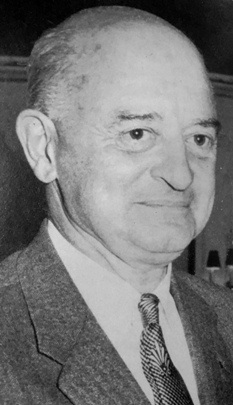
If you look up the word rare in the dictionary you will find it has several meanings, such as the way some people like their meat cooked, to a precious gem some wife might like to have her husband give her for Christmas.
As far as an orchid is concerned I think the one that defines it as “uncommon” is the most appropriate, but it does not go far enough. I would define a rare orchid as one that very few people have, but many people want. You might have the only piece of a plant in existence, but if nobody else wanted it, so what! I have some seedlings in this category, but I don’t consider them rare.
When Dean Field persuaded me to talk to you tonight he never gave me the slightest hint as to what might be of interest to you. As this is the third time I have appeared before this group he should have known better than to ask me. [Dean Field was President of South Coast Orchid Society in 1953 and 1954. He also served as President of Orchid Digest Corporation in 1955 and 1956, and of Orchid Society of Southern California in 1957. By 1959, he was in charge of the Southland Orchid Show as well as program chairman for SCOS.]
After worrying about the matter for a couple of weeks I decided that rather than try to find some topic to please you, perhaps if I would just please myself I would enjoy it more, and those who don’t enjoy what I have to say might not like some other topic either.
One of the things I like to do in connection with orchids is to delve into the history and romance of this great family of plants we all admire. The only other plant that compares with it at all in colorful history is the Camellia, and while the Camellia is interesting, it really isn’t in the same league, as the saying goes.
Most of you who know me well realize that my principal interest in orchids centers on two genera . . . cymbidium and cypripediums. However, I have studied other genera, less thoroughly than my favorites, and the literature on Cattleyas and Dendrobiums contains some fascination stories which add much wealth to our orchid lore.
The plant explorers who discovered, collected, and brought back to England the orchid species of our present day hybrids, did a magnificant job, even if some of them were ruthless in the way they cleaned out the locations where they found these plants. We orchid growers of today should not forget these men and to me the history of the collection of species orchids is a romantic and charming facet of orchid growing. My remarks will be confined to only a few genera and I’ll start with Cattleya labiata.
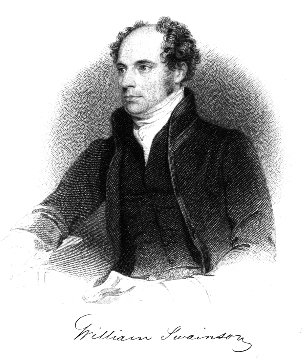
William John Swainson 1789-1855, naturalist, artist, and the discoverer of C. labiata
Cattleya labiata: Discovered, Lost, and Re-Found
As you cattleya growers know, this species is native to Brazil and is a very variable one. Its importance as a parent of present day hybrids is considerable, and I won’t recite its many virtues, which you undoubtedly know. One interesting aspect of it is its discovery by William Swainson in 1817, who sailed from England in the autumn of 1816 and landed in the Province of Pernambuco, Brazil, 8 degrees south of the Equator about the end of December 1816. He was delayed owing to a political revolt, but collected several plants of which some he described as “parasites”. His drawings and collections were dispatched to Dr. Hooker and a Mr. William Cattley in June 1817 from Rio de Janeiro. Of the plants received by Mr. Cattley there were Oncidium barbatum, Catasetum hookeri, and a third plant which bloomed in the Cattley stove-house in November, 1818.
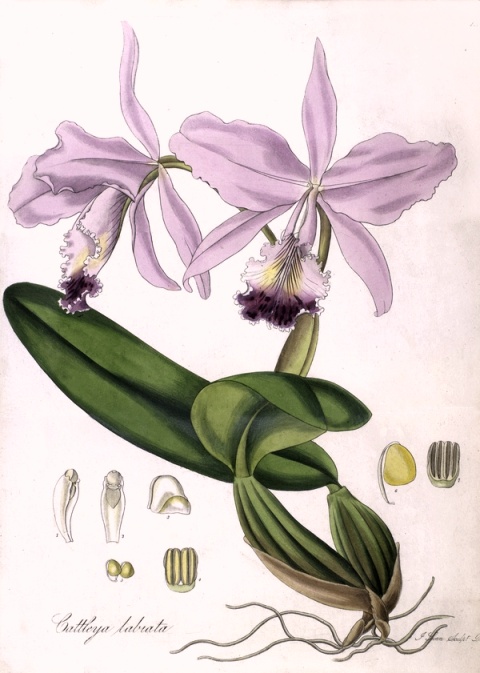
Second known figure of Cattleya labiata, from Hooker's Exotic Flora 2:157 (1825)
Nothing like it had ever been seen before in England and it created a sensation in the horticultural world. It was referred to Dr. Lindley for identification, who declared it a new genus (and species), which he named Cattleya labiata.
Swainson never told anyone where he found this precious plant, and for years plant explorers searched for it in vain. Finally in November, 1836 Gardner found it near Rio de Janeiro growing on a precipice of a mountan called Pedra Bonita and was able to collect a few plants and ship them to England. [By then, reports from Brazil told of the complete deforestation of these habitats; it was widely assumed that any wild populations had been wiped out.] Over 50 years elapsed before it was again located in Pernambuco and sent to England in quantity in the early 1890’s. In November, 1893 Charlesworth, Shuttleworth & Co. had a display in their houses of 7,000 flowers of this first of the Cattleyas in a marvelous range of coloration.

Advertisement from Gardeners' Chronicle, September 12, 1891, announcing sale of the first group of C. labiata to reach England in many decades
[The rediscovery of a wild population of Cattleya labiata caused a sensation when a shipment of at least 600 plants reached England. F. Sander & Co. announced an auction of these plants in the September 12, 1891 issue of Gardeners' Chronicle. Later accounts provided some additional details about the find. An account of Swainson's travels in Brazil had been published in 1819 and remained unnoticed by the botanical community. This was perhaps not surprising, because Swainson was known mainly for his description of many new bird species. Several articles on this subject were written by R. A. Rolfe: Cattleya labiata, Lindl., Gardeners' Chronicle Ser.3:vol.10,336-368 (September 26, 1891); Cattleya labiata, Orchid Review 1:329-331 (1893); Cattleya labiata and its habitat, Orchid Review 8:362-365 (1900).]
With this species the great genus Cattleya was founded and subsequent discoveries and hybrids have combined to create the magnificent orchids so many of you admire.
A New Rare Cattleya
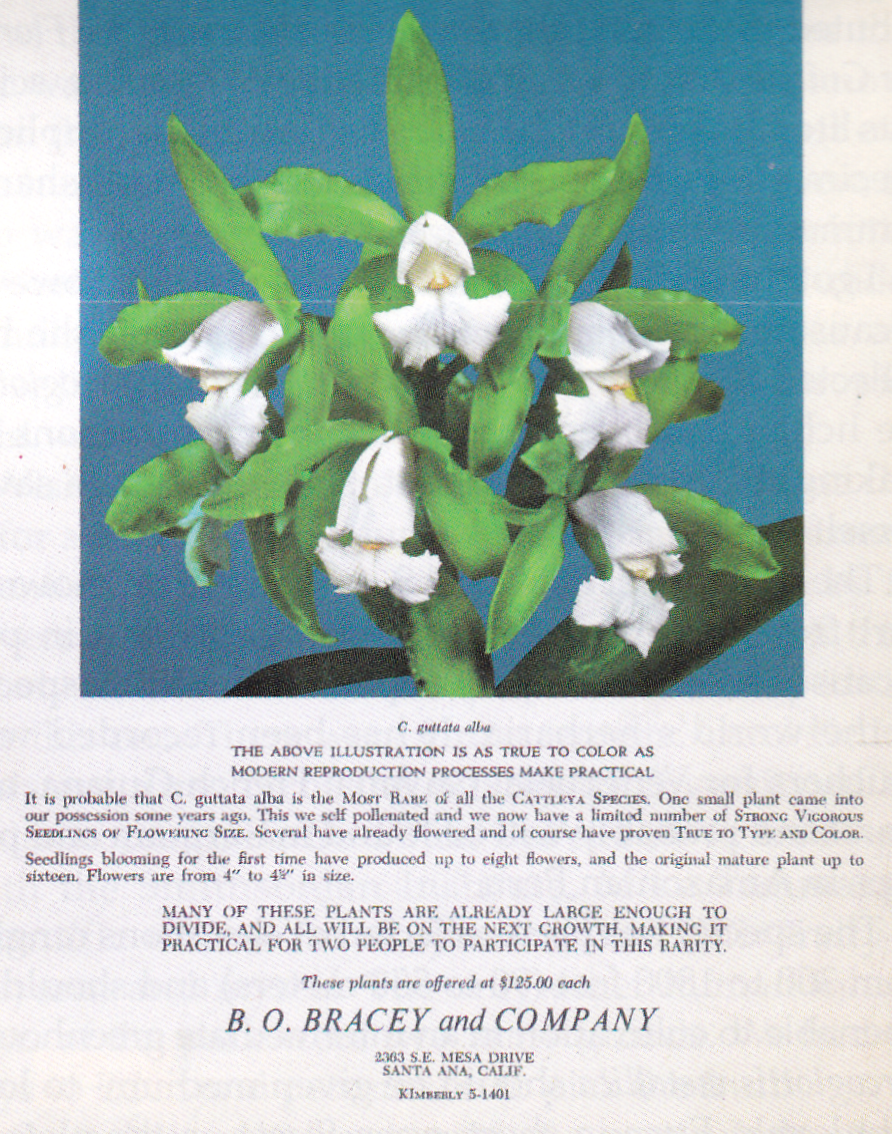
Bracey's advertisement published in Orchid Digest in the late 1950's. When the pandemic subsides and we can get back into the libraries, we will get a better picture. This one was published in a short retrospective about this plant by Ernest Hetherington in Orchid Digest 63:20 (1999). Note the suggestion that two people could easily buy a plant together and divide it. The plants for sale were seedlings from a selfing of the original plant. Photograph of the original advertisement was provided to Hetherington by movie special effects wizard and SCOS judge Howard Anderson Sr.
I could go on and recite the stories of the discovery of other important Cattleya species such as Dowiana var. aurea, but to me one of the most modern ones is of special interest. Just a few years ago Mr. B. O. Bracey secured from an unrevealed source a small plant of Cattleya guttata var. alba. This plant was so rare that you can hardly even find it mentioned in any of the orchid books or publications. The only place I have found it is in the Orchid World, a long discontinued magazine. So far as I know there is no other reference to it in orchid literature. Belonging as it does to the bifoliate group the flowers open as a cluster and may have as many as two to twelve or more on one flowering stem. The sepals and petals are a clear lettuce green and the labellum almost pure white. Many of you have undoubtedly seen it in flower.
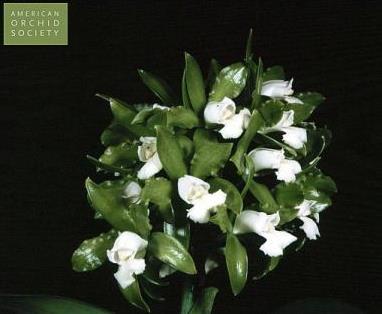
© 1972 AOS
C. leopoldii (formerly guttata) alba 'Field's', HCC/AOS, award photo from 1972. 'Field's' is one of the seedlings from the self-pollination of Bracey's original C. guttata alba. It is named for Roy Field, a long-time member of SCOS, not related to former SCOS President George Dean Field.
Mr. Bracey recognized the great value of this novelty and has perpetuated it by self-pollination. So far all of the progeny have come true indicating that it is a true species. While the story of the re-discovery of Cattleya guttata var. alba may not have the glamour of some other orchid discoveries, don’t let the fact that it happened at your back door influence your judgement of its importance to orchid growing and future hybridization. Cattleya breeders should start working on this little gem.
Dendrobium phalaenopsis var. schroederianum
[Mr. Casamajor is here quoting and paraphrasing Frederick Boyle's The Woodlands Orchids, pp. 113-120 (1901). Boyle indicated that the name of the island where Dendrobium phalaenopsis var. schroederianum was discovered had not yet been revealed to the public, but suggested the information would eventually be forthcoming. Today the answer is known, and the variety schroederianum is claimed by some to grow only on the island of Larat in the Tanimbar Islands, part of the Maluku Islands (Moluccas) of Indonesia, south of Timor. The airport on Larat is located at Lat 7° 7' 42S, 131° 46' 2E.]
The Dendrobium genus may not arouse in many of you any thoughts of romance or adventure but the pure white form of Dendrobium Phalaenopsis now known as variety Schroederianum has a long and interesting history. This rare plant was sent to Kew Gardens about 1875 by Forbes. It remained a special trophy of the Royal Gardens for many years. Eventually Sir Joseph Hooker gave small pieces of it, in exchange for other varieties, to three people, one of whom was Baron Schroeder. He proceeded to acquire the other two plants and thus had all of the variety known to exist in private hands, whereupon this variety took his name. This state of things lasted ten years. Unable to get any of the plant Mr. Sander resolved to try to re-discover it in its native haunts. He studied the route of Forbes’ travels and in 1890 sent Wm. Micholitz to seek Dendrobium Schroederianum.
Plant hunters in those days were an evasive lot and any ruse to throw others off your trail was considered fair practice. It was universally understood that Micholitz discovered the object of his quest in New Guinea. Maybe that is why so many explorers went to that interesting and fertile island to search for plants, but they never cam back with Dendrobium Schroederianum because it wasn’t there.
William Micholitz was one of the most skilled and presistent of plant hunters, but the story of how he found this white beauty would scare some of you out of a night’s sleep. Events didn’t move as fast in those days and you had to know how to fraternize with ship captains and entice savages into doing you favors. Biding your time, on a plant hunting quest was one of the fine arts. Nobody else was in a hurry, so how could you be? I won’t attempt to recite to you the whole lurid story as was told by Frederick Boyle in his book, “The Woodlands Orchids”, suffice to say that Micholitz arrived in a trading-vessel, the captain of which was trusted by the natives. His destination was one of the wildest isles which stud the Australasian Sea, and some nice calculations by Mr. Sander with the help of the staff of Kew Gardens enabled Micholitz to land at the right spot near the end of the dry season.
Under protection of the chiefs he was allowed to explore, but their power did not stretch beyond a few miles of the coast. The neighbors on each side were unfriendly, and bitterly hostile tribes lay beyond. All alike were head hunters and the captain assured Micholitz the best-intentioned of these islanders cannot always resist the temptation to crown their trophies with a white man’s head.
There were no plants near the little port and Micholitz knew he must venture futher. After a few days he was told the chiefs were going to a feast and that he might accompany them. The Captain could not go and looked at Micholitz with a hesitating air.
“Is there any danger?” Micholitz asked.
“On, no, not a bit of danger, you’ll be amused I daresay, they’re rum chaps.”
At daylight he started with the chiefs. It was but a few hours paddling to the next bay. They embarked, paint and feathers, spears and clubs and were met by their hosts in the same guise upon the beach.
After a priest howled for a while the warriors began to dance two by two. It was wearisome and very hot. At length Micholitz asked if he might leave. The interpreter said there was no objection. He walked toward the forest which was some distance back. As he approached he noted that a channel had been dug in the land leading to the trees. This he skirted and when he parted the foliage observed a low temporary building which he assumed held the war canoe about to be launched and christened by the party on the beach. But to his horror he saw on looking further two naked human bodies impaled on spears, one on each side of the building. Hardly had he recovered from this shock than the party on the beach broke up with wild screaming and yelling and led by the chiefs all rushed upon the building tearing down the walls. When the head men were in their place in the prow, all others laid hands on the craft and started it moving down the channel to the water. The din and noise was deafening.
Frightened as he was when the rush started Micholitz had retreated from the launching site and made his way as best he could deeper into the forest. He told himself he had come to look for orchids not be a witness to a bloody spectacle and had better be about his business. He was so sick from the savage spectacle he hadn’t noticed what was above him in the low trees. Sudddenly he realized they were garlanded with orchids, some red, and one a deep purple, then glistening in a shaft of sunlight a large cluster of the purest white. Dendrobium Schroederianum had been re-discovered! Success drove all else from his mind, or almost, until the interpreter summoned him to sit down with the savages and eat their dubious viands. When the chiefs understood this eccentric white man fancied their weeds they offered them joyously—at a price.
Next day Micholitz returned aboard and the Captain brought his ship round to the bay. In three days, so plentiful was the supply Micholitz had gathered as many as he thought judicious and heaped them on deck. They could be dried while the vessel was waiting for cargo elsewhere. The Captain filled up quickly and sailed for a Dutch port where the orchids would be shipped to England. He arrived in the evening, the ship lay alongside the wharf; next day the precious cases would be transferred to the steamer. Content with his labors Micholitz went to sleep, so did everybody else, the watch included. Toward morning the harbor police raised a cry of ‘fire’. It must have been smoldering for hours. Not one plant could poor Micholitz save. On arrival he had telegraphed his success and joy reigned at St. Albans, but the next morning the second message arrived.
“Ship burnt. What do? Micholitz”
The reply:
“Go back. Sander”
“Too late, rainy season”
“Go back”
And Micholitz went, though the way was difficult and the rain grew heavier daily. Taking a mail steamer to the nearest settlement he worked his way back. But at this spot the Dendrobe was growing on limestone rocks and was especially abundant in the graveyard of the clan, a stony waste where for generations they had left their dead. The plants grew and flowered among bones innumerable, where they were not only the most plentiful but by far the most vigorous. Nervously Micholitz suggested their removal after displaying samples of his trade; looking-glasses, knives and beads. A clamor of indignation broke out among the warriors. It was swelling into a passion when he produced a roll of brass wire. That calmed them, and after debate they stipulated they would not assist in collecting, but if two of their most sacred idols should travel with the plants and be treated with honor, all the way, they would agree. After distribution of the brass wire they helped pack the cases.
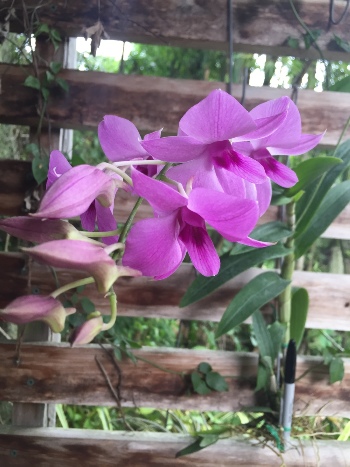
© 2015 Motes Orchids
Den. striaenopsis from the Maluku Islands, offered for sale a few years ago from Motes Orchids
Thus it happened that one of the Dendrobes sold at Protheroe’s Auction Rooms on October 16, 1891 was attached to a human skull. As for the idols they were bought by the Hon. Walter Rothschild and it is hoped they were treated with reverence, as per the agreement.
[What happened to these plants? There was an FCC awarded by the RHS, March 22, 1892, but we were unable to locate an illustration of any of plants collected by Micholitz. While Boyle says the desired variety had white flowers, we don't know if Micholitz collected plants of all the color variations that he found on Larat. Today, there are plants labeled as variety schroederianum in all the usual colors of the traditional "Dendrobium phalaenopsis".]
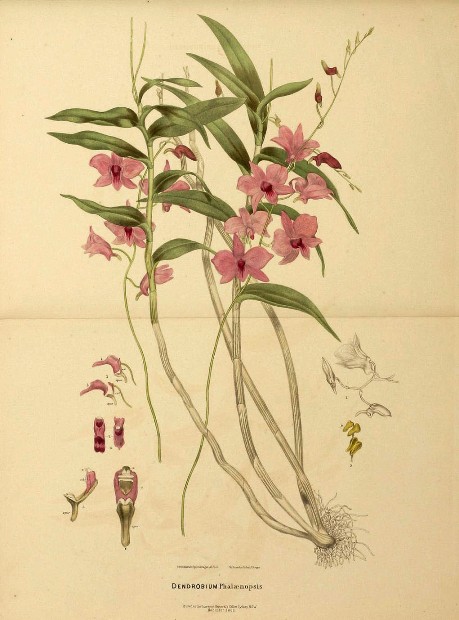
Original illustration of Robert FitzGerald's newly described Dendrobium phalaenopsis (1882), presumably the very same plant that he had "obtained" in Cooktown, Queensland, Australia (R. D. FitzGerald, Australian Orchids, vol. 1)
April, 2021: But the science and the story have moved on! Many had wondered if Den. bigibbum and Den. phalaenopsis would better be regarded as a single species. If so, it would have to be called Den. bigibbum, which has priority (described by Lindley in 1852). However, there are complications. For example, it is not entirely clear where the plants from which bigibbum and phalaenopsis were described actually came from. One idea is that, if they are to be regarded as separate species, phalaenopsis would apply to plants from the east side of the Great Dividing Range (the original description by FitzGerald in 1880 involved a plant "obtained" at Cooktown, Queensland), in the northern part of Queensland, and bigibbum to the plants from the west side of the range as well as those from the islands in the Torres Strait and Papua-New Guinea. The status of the Indonesian forms was unknown.
At this point, in 1989, after deciding that the name schoederianum was invalid and therefore unusable, and that all three forms deserved species rank, Mark Clements, in the context of a taxonomic inventory of the known orchids of Australia, described the plants from Indonesia, formerly known as schroederianum, as Den. striaenopsis, with only the briefest hints as to why these forms should be given the rank of separate species, as opposed to treating them as varieties of a single species.
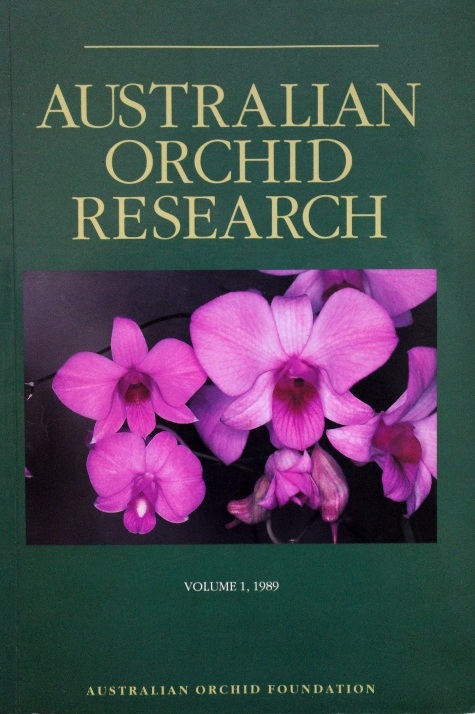
Photo and entire volume © 1989 Mark Clements and David Jones
Cover of Australian Orchid Research, vol. 1: The three proposed Dendrobium species in life, side by side. Top left, Den. phalaenopsis; top right, Den. striaenopsis sp. nov.; bottom left, Den. bigibbum. (See text.)
About the best single demonstration of the differences among these three forms turns out to be on the cover of Australian Orchid Research, volume 1 (1989), devoted to Mark A. Clements' "Catalogue of Australian Orchidaceae", which includes Den. bigibbum on pp. 47-48, Den. phalaenopsis on p. 59, and, as an Addendum, the formal description of Den. striaenopsis M. Clements et D. Jones, sp. nov. on p. 148. Anyone who searches for this volume on the internet (for example, when trying to obtain a copy of an article or species description) is likely to find an image of the volume cover, but few will realize that the cover shows selected, apparently typical forms of, top left, Den. phalaenopsis, from the McIlwraith Range, Queensland, Australia; top right, Den. striaenopsis (the traditional schroederianum), from Tanimbar Island, Indonesia; and, bottom left, Den. bigibbum, from Horn Island, Torres Strait, Queensland, Australia — the key to the cover illustration is on the inside of the cover. With the flowers in full bloom, side by side, it is easy to see the differences: the prominent white crest (but not all bigibbum plants have this feature) and very rounded form of bigibbum, the more open form of phalaenopsis, and the larger size and especially the more prominent striations of striaenopsis. There are also differences in the edge of the lip.
But the RHS apparently went for a time in the opposite direction, using phalaenopsis for the Indonesian plants and bigibbum for all of the Australian plants. Also in the running is the proposal (2002) that the old Den. phalaenopsis, with or without bigibbum etc., should be split out as a new genus Vappodes. If that idea gains traction, it would require the creation of at least half a dozen new intergeneric hybrid names. In addition, it has been pointed out that it is now likely impossible to decide which of the various proposed species names should apply to any particular cultivated plant, because they have all been in cultivation over a period of many years, during which opinions about the names have changed repeatedly, and probably the labels with them. In addition, the "best" varieties have been interbred, without regard to where they may have come from, selected for color, form, etc., and then labeled with whatever species name was currently in fashion.
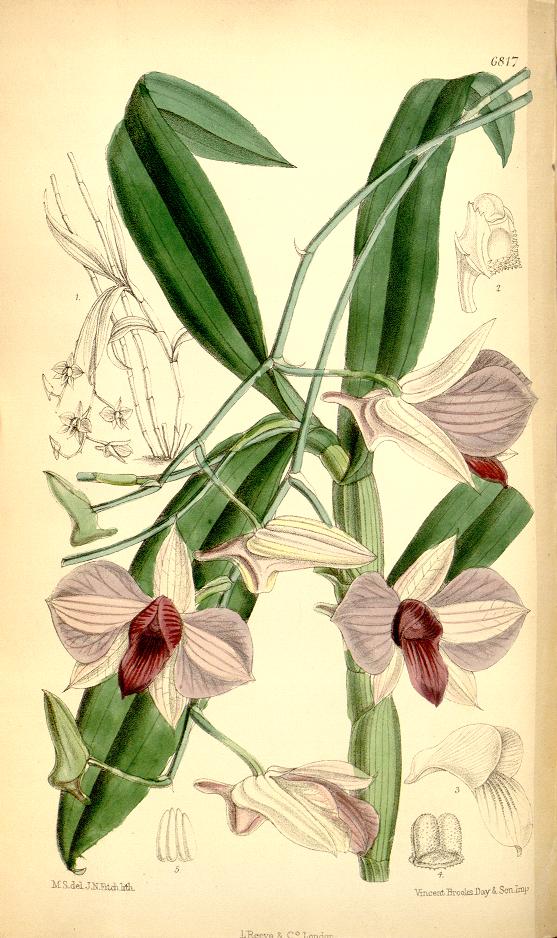
The original plant collected by Forbes and still at Kew in 1885, and later to be known popularly as Schroederianum, depicted in the color plate accompanying Sir Joseph Hooker's account of Dendrobium phalaenopsis, Curtis's Botanical Magazine, ser. 3, vol. 41, Tab. 6817 (1885). This is what all the fuss was about.
A mention in Jim Endersby's Orchid: A Cultural History (Chicago and London: University of Chicago Press, Kew Publishing, 2016, see especially p.118) pointed us to some important details. Sir Joseph Hooker, then director of the Royal Horticultural Society and at the centre of all things Botanical in the British Empire, published an account of "Dendrobium Phalænopsis" in Curtis's Botanical Magazine, ser. 3, vol. 41, Tab. 6817, illustrated by a specimen of the identical, original "Schröderianum" collected by Mr. Henry Ogg Forbes during his "adventurous expedition" to "Timor-laut" in 1882 — in other words, the authentic and allegedly extremely rare plant that Micholitz had risked his life to find again in 1891. Sir Joseph first explained the differences between Den. phalaenopsis and Den. bigibbum (the latter he found "quite distinct in its much smaller size, fewer much broader more uniformly deep rose-coloured flowers, shorter crested lip, simple saccate spur and longer column"), as well as a brief discussion of the similar species that had been described, Den. superbiens, goldei, and sumneri. From this account in 1885, we can see that Hooker knew perfectly well where Forbes had obtained this plant, which the rest of the orchid world had found so mysterious, apparently as a result of errors in the popular press. And what did Hooker think of Forbes' specimen? "The specimen here figured is one of the few botanical prizes secured to England by Mr. Forbes during his adventurous expedition to Timor-laut (see Journ. Geograph. Soc. vol. vi. p. 113). It is probably the handsome species alluded to in the Report of the Botany of his expedition at p. 371 of the Journal of the Linnean Society, vol. xxi., as found on trees in Lavat. This gives the species a wide range in distribution, and I can detect no difference between the Australian and Timor-laut plants, except that Mr. Fitzgerald implies that the flowers [Hooker is referring here to the type specimens from Cooktown, Queensland] are erect in his plant, whereas they are decidedly pendulous in ours..." Then Hooker describes the details of the plant in the Kew collection, evidently the one from "Timor-laut". For Sir Joseph, this was the best and possibly only speciment of Den. phalaenopsis at hand, and he clearly regarded it as representative and indistinguishable from the specimen described by Fitzgerald, and distinct from bigibbum. Schroederianum wasn't such a special orchid after all, even if Micholitz's breathless adventures and the plant growing out of a human skull would make it a hot commodity in 1891. Also to be noted, Hooker did not support or even mention the idea that schroederianum deserved the rank of subspecies or any other special designation. We're not at all sure that everyone understands that this figure is of the original schroederianum, and thus possibly the key to sorting out the later confusion of names! The "Internet Orchid Species Photo Encyclopedia" has missed this entirely. OrchidWiz has found the color plate, but failed to realize that it is the original schroederianum.
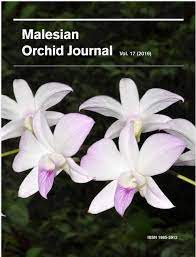
The latest chapter seems to clarify both the natural history and the taxonomy. There is at last a review of the situation based on analysis of measurements from wild-collected plants (Peter B. Adams, 2015. Dendrobium bigibbum (sect. Phalaenanthe) in Australia: Analysis of diagnostic characters, review of taxa and a new classification, Kew Bulletin, 16:1-17). For the Australian plants, Adams found no support for maintaining separate species, because the minor differences that exist overlap and intergrade. Instead, most of the Australian plants can be assigned to three varieties: Dendrobium bigibbum var. bigibbum for the plants at the top of Cape York, var. superbum for the traditional "Cooktown orchid" (the one that was formerly Den. phalaenopsis), and var. compactum for a small population at the southern end of this species' range. The remaining minority of Australian plants appear to be intergrades among these "varieties". The Indonesian plants are assigned currently to var. schroederianum (Peter B. Adams and Sheryl D. Lawson, 2016. Classification, variation and biogeography in the Dendrobium bigibbum Lindl. (section Phalaenanthe) complex, Malesian Orchid Journal, 17:7-32 — and once again, it is the cover of the journal volume, easily found on the internet, that provides the most accessible illustration of the variety schroederianum, although the article itself has dozens of photographs of wild-collected specimens, along with extensive morphometric and genetic data!) — which establishes the extent of measurable and consistent differences between this variety and superbum. This conclusion, assigning all of these "varieties" to a single species name, in any case, would seem to bring with it a much-needed stability, although at this writing, the RHS orchid registration system seems still to recognize a separate Den. phalaenopsis, possibly as a temporary expedient while the fate of the grex names involving the suppressed species is worked out.
For those who are flumoxed by the name bigibbum, it means "having two humps", and you can pronounce it like "Bye, Gibb-um", with a hard G. However, the idea that Latin is the world-wide, standardized language of taxonomy is somewhat deceptive, as anyone who has attended an international conference where taxonomists are present can attest: Everyone pronounces Latin names according to their own notions, and especially, the way they learned them from their professors. The spellings are the same internationally, but the pronunciation is not.
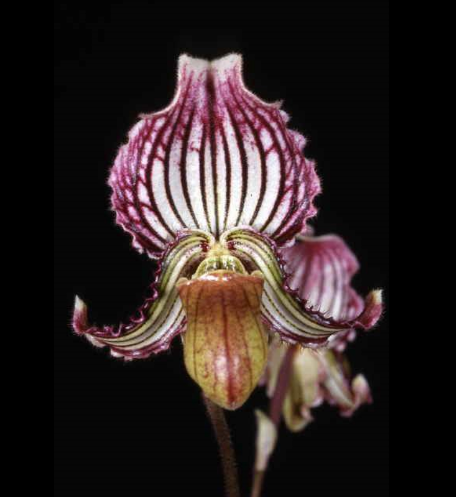
© 1994 AOS
Paphiopedilum fairrieanum 'Jeepers' HCC/AOS, exhibited at our Long Beach meeting December 19, 1994 by Paphanatics, unLtd. (that's our friends Harold Koopwitz and Norito Hasegawa)
Paphiopedilum [formerly known to orchid hobbyists as Cypripedium] fairrieanum
Now we come to Cypripedium Fairrieanum and its colorful history. I’m sure I don’t have to describe this flower to you because many of you are growing it. It has a distinct charm, and there is no other species like it. It has also been the despair and pride of orchid growers for over 100 years. The many attempts to cross it with other species and hybrids have produced some of the most colorful and astonishing progeny that exist in the genus. In several instances only one seedling survived and flowered, but the result was a sensation in its day.
No one knows who first discovered this plant, but it came into English cultivation and flowering in October 1857, when it was shown at a meeting of the Horticultural Society by a Mr. Fairrie of Liverpool and was described and named for him by Dr. Lindley. Two other growers bloomed it at about the same time, and the three plants all came from a consignment of East Indian orchids sent from Assam and sold at auction in London on March 24, 1857. Apparently this species bloomed within seven months after receipt from India.
Now Assam is one of the warmer provinces of India. Therefore growers assumed it required warm treatment. Undoubtedly this was their undoing. They overlooked the fact that M. Van Houtte in his magazine “Flore de Serres”, a French publication, told that he had received the plant from a collector in Bhotan, which is a northern province at elevations around 7000 feet and much colder than Assam.
From a goodly stock of this species breeders in both England and France spread its pollen around and produced many remarkable hybrids. All attempts to self it, or use it as a pod bearing parent were doomed to failure.
One by one, growers lost their plants or they shrunk in size to the class of mere seedlings. Division for the purpose of increase was disastrous. By 1876 there were few plants left, worthy of the name, in England or on the continent. The last recorded exhibit was at a meeting in 1887, a single plant.
Explorers went forth, based on the assumption it had come from the Garo Hills in Assam, and sought to re-discover it. Their efforts were in vain. All they had left were the dried herbarium specimens at Kew and the many hybrids in the hands of growers.
Sander came forth and posted a reward of £2000 for the discover and delivery into their hands of a quantity of plants of the lost orchid. This made first page news in the London newspapers and the search began anew. By 1905 most growers had given up hope of again ever seeing Cypripedium Fairrieanum. But in March of that year there appeared a story in Indian Planting and Gardening of Calcutta entitled “The Lost Orchid Found”. I quote:
“Every horticulturalist in general and orchidist in particular will be interested to learn that the ‘lost orchid’ Cypripedium Fairrieanum has been rediscovered. The discoverer is an Englishman; and he with Mr. S. P. Chatterji, the well known florist and nurseryman of Calcutta, have the secret of its natural habitat between them. They have a fine stock of plants and will doubtless make the most of them in due course. They will now claim the reward of £2000 offered by a London firm of plant merchants to anyone who could re-discover the ‘lost orchid’. The locality where this orchid was found remains a profound secret for the present, but it was not found in the Garo Hills, its supposed natural habitat. There is no doubt as to its identity as it has been submitted to Dr. Prain, Superintendent of the Royal Botanic Gardens, Calcutta, who has pronounced it ‘Simon Pure’. The plant was lost to the world in 1876 and can be said to be practically extinct in Europe at the present time.
“This is probably the most important and sensational announcement the horticultural world has received for many years and ranks with the rediscovery of Cattleya labiata in Brazil in the 1890’s. In due time the name of the discoverer and full particulars as to the conditions under which it was found growing and its locality will be published.”
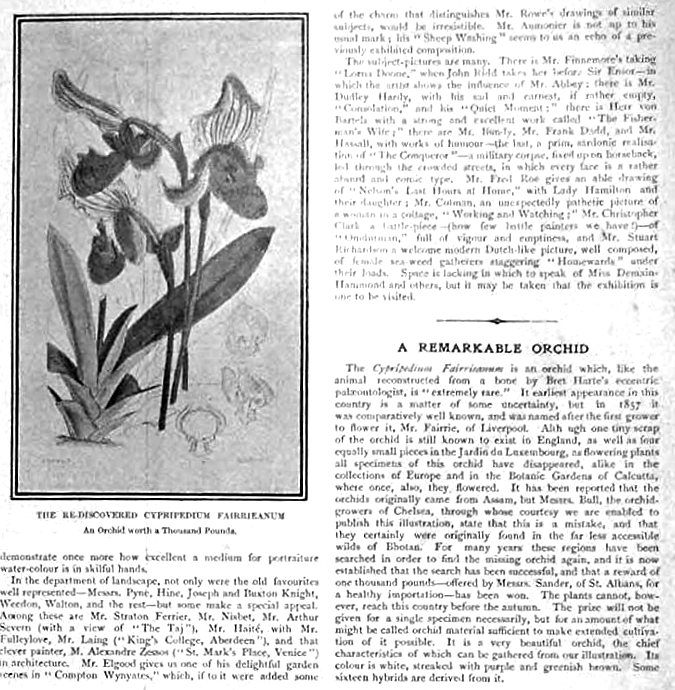
News about the rediscovery of Paph. fairrieanum from the illustrated weekly, The Graphic (London, April 27, 1905). The figure is a much earlier illustration, not from the newly discovered specimens, as the plants that had just arrived in England still had not bloomed. The first flower opened on August 16, 1905.
On April 14th, the Times and other London newspapers gave the re-discovery first page publicity, and the “Morning Leader” said it had been found the previous autumn by an engineer out hunting for grouse or pheasant. Final comfirmation came from Kew when they received on April 26 two fine unestablished masses of a Cypripedium described as ‘unknown species from the Eastern Himalayas’ which they identified as C. Fairrieanum. The plants had been shipped to them from Calcutta.
This settled it as far as the orchid fanciers were concerned and Sanders were besieged by their many customers for some of the plants when they arrived.
On July 22nd the “Gardiners' Chronicle” announced that Cypripedium Fairrieanum had arrived at St. Albans at last, and that the young scapes on the plants at Kew left no doubt as to their identity.
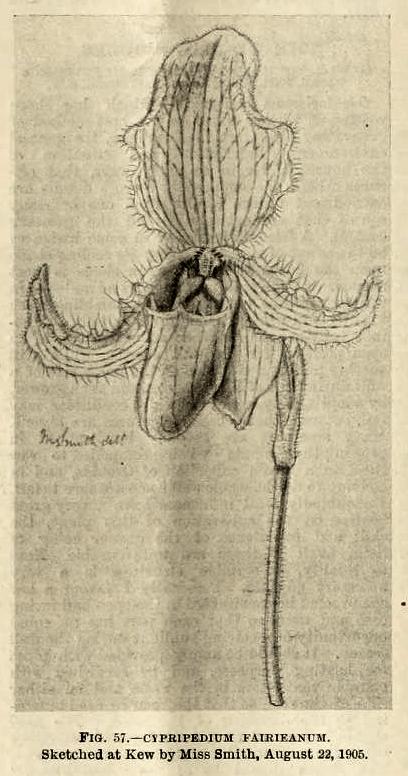
The first flower of the rediscovered Paphiopedilum (at that time Cypripedium) fairrieanum, published in Gardeners' Chronicle August 26, 1905 (p.168) — the long-awaited proof that the new plant really was fairrieanum
After satisfying the demands of their royal and wealthy customers Sanders offered 179 plants at auction on September 15th at Protheroe and Morris’ Auction Rooms in London.
Bidding was spirited at times and the total consignment brought £550. The best plant with one flower spike went for 21 guineas, which at that time would have been about $100.00.
Finally in December 1905 there came from India the information the Cypripedium Fairrieanum was discovered by Mr. G. L. Seabright of Darjiling, an amateur gardener, who happened upon the plant growing in niches of gneiss rock at an elevation of 7000 feet near the head waters of the Torsa River in the Bhotan Hills country. Thus it appears that assumption by growers it had at first been found at elevations of 3000 feet was the major cause of its gradual demise under cultivated conditions, when they should have arranged for temperature consistent with 7000 feet. It also appears from the record that when grown warm it is particularly susceptible to damage by thrips.
So now I close my story of the rediscovery of famous orchid species, and I hope you have enjoyed the recital as much as I did digging it out of the authentic sources.